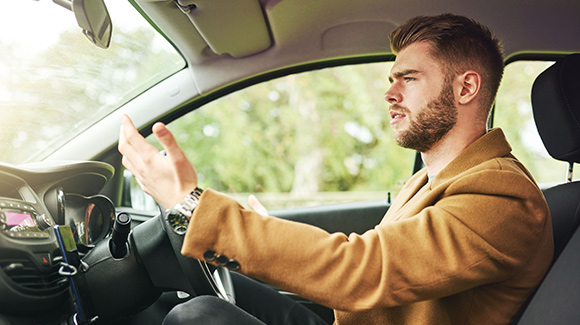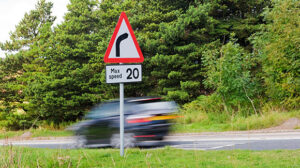Home » Driving Advice » Tailgating driving
Tailgating driving: Here's what you need to know
Many drivers will have likely experienced tailgating at one time or another. Being on the receiving end of someone that is driving too close may leave you angry, frustrated or force you to act in a way that may put other road users in danger.
In this article, we cover everything you need to know about tailgating and what you can do if someone is driving too close to you.

What is tailgating?
Tailgating is when a motorist drives too close to the vehicle in front of them. While many drivers unintentionally tailgate, a small minority tailgate deliberately to pressurise, intimidate, or bully the driver in front. This may force the tailgated driver to speed up or take unnecessary risks that might put other road users in danger.
Tailgating is a dangerous practice because it gives the tailgater less time to think and react if the driver in front was to suddenly stop. It could also result in a serious accident. A study by Highway England shows that 1 in 8 casualties on UK roads is caused by tailgating.
Why do people tailgate while driving?
There are several reasons for tailgating. Most drivers are unaware that they are driving too close to the vehicle in front. This usually happens due to a lack of concentration behind the wheel. Some drivers tailgate when they are preparing to overtake the vehicle in front of them.
Other drivers tailgate as an aggressive form of driving to bully or intimidate the driver in front to force them to move over so that they can pass. Then there are the drivers who tailgate because they are in a hurry. This can sometimes be due to poor planning and not allowing enough time to complete their journey.
Work pressures may also contribute to tailgating. For instance, drivers that needs to complete a high volume of drop-offs or get passengers to and from their destination by a certain time.
Some motorists may tailgate because they are encouraged to do so by their passengers.
There is nothing to gain from tailgating. Some drivers may feel that by putting pressure on the driver in front they can reach their destination quicker. But they will inevitably get caught up in the traffic in front and may only save minutes off their journey time. Furthermore, braking suddenly can increase fuel consumption and cause significant wear and tear to their vehicle. It may also contribute to road rage.
What is the safe distance between two vehicles?
In dry conditions, drivers should always allow at least a 2-second gap from the vehicle in front. This gap should be at least doubled in wet conditions and widened further in icy conditions.
If you’re in doubt, remember the saying ‘only a fool breaks the 2-second rule.’ When the vehicle in front passes a fixed point, such as a sign, start to say, ‘only a fool breaks the 2-second rule.’ If you pass the same fixed point before you’ve finished saying the phrase, you are too close to the vehicle in front and should leave more space.
What to do if a driver is tailgating you?
Do not allow the tailgater driver to intimidate or force you to take risks behind the wheel. Remain calm and don’t allow your emotions to get the better of you. Instead, stay in control of the vehicle so that you can drive safely and allow them to pass.
It also helps to review your driving style. Are you driving in a way that might frustrate or provoke the tailgater? Bear in mind that driving too slowly can be an offence.
Allow tailgaters the opportunity to overtake you where possible by driving at a steady speed. Gently ease off the accelerator, allowing more space in front of you for them to pass.
You could also pull over to the side of the road, ensure that you signal in plenty of time to allow the follower to pass you. Do not pull over on the hard shoulder of a motorway though, as this lane is for emergency use only. Instead, keep to the left-hand lane.
If you’re turning off the road, signal and adjust your speed in plenty of time so that the tailgater is aware of your intentions.
Always remain in the left-hand lane unless you are overtaking another vehicle. As soon as you have overtaken the vehicle, signal and move back to the left-hand lane when it is safe to do so.
Do not speed up, all this will do is encourage the tailgater to do the same to match your speed. Instead, maintain a steady speed and do not allow the tailgater to intimidate or bully you into driving unsafely.
You should also avoid slowing down or using your brakes to irritate the tailgater or force them to slow down. Not only could this be dangerous, but it could also exacerbate the situation.
Always be aware of everything that is going on around you, don’t stare in your rear-view mirror at the tailgater, focus on the road ahead.
What are the penalties for tailgating?
Tailgating is illegal and can result in a careless driving charge. Drivers found guilty of tailgating could be hit with a £100 fine and penalty points on their driving licence. In more serious cases, penalties can range from a driving ban to a prison sentence.
Final thoughts
Tailgating won’t help a driver reach their destination any quicker. Instead, it will increase their chances of being involved in a serious accident.
Should you find yourself being tailgated, remain calm and drive as normal.
Share this article
Table of Contents
More posts

What Happens If You Drive In A Bus Lane By Mistake?

What Happens If You Speed With A Black Box?

UK Speed Limits: Here’s What You Need To Know

